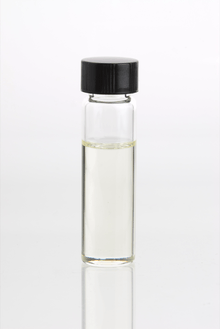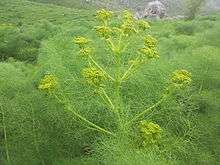Galbanum
Galbanum is an aromatic gum resin and a product of certain umbelliferous Persian plant species in the genus Ferula, chiefly Ferula gummosa (synonym F. galbaniflua) and Ferula rubricaulis. Galbanum-yielding plants grow plentifully on the slopes of the mountain ranges of northern Iran. It occurs usually in hard or soft, irregular, more or less translucent and shining lumps, or occasionally in separate tears, of a light-brown, yellowish or greenish-yellow colour, and has a disagreeable, bitter taste, a peculiar, somewhat musky odour, an intense green scent, and a specific gravity of 1.212. It contains about 8% terpenes; about 65% of a resin which contains sulfur; about 20% gum; and a very small quantity of the colorless crystalline substance umbelliferone. It also contains α-pinene, β-pinene, limonene, cadinene, 3-carene, and ocimene.[1]

Uses

In the Book of Exodus 30:34, it is mentioned as being used in the making of the Ketoret which is used when referring to the consecrated incense described in the Hebrew Bible and Talmud. It was offered on the specialized incense altar in the time when the Tabernacle was located in the First and Second Jerusalem Temples. The ketoret was an important component of the Temple service in Jerusalem. Rashi of the 12th century comments on this passage that galbanum is bitter and was included in the incense as a reminder of deliberate and unrepentant sinners. The incense formula was apparently ground small[2] or into a powder[3]. This would be possible because Galbanum, which is a sticky tar-like resin, can be made into a powder by drying, low boiling, or adding a diluent[4]
It is occasionally used in the making of modern perfume, and is the ingredient which gives the distinctive smell to the fragrances "Must" by Cartier, "Vent Vert" by Balmain, "Chanel No. 19" and "Vol De Nuit" by Guerlain. The debut of Galbanum in fine modern perfumery is generally thought to be the origin of the "Green" family of scents, exemplified by the scent "Vent Vert" first launched by Balmain in 1945.
Hippocrates employed it in medicine, and Pliny (Nat. Hist. xxiv. 13) ascribes to it extraordinary curative powers, concluding his account of it with the assertion that "the very touch of it mixed with oil of spondylium is sufficient to kill a serpent." The drug is occasionally given in modern medicine, in doses of from five to fifteen grains. It has the actions common to substances containing a resin and a volatile oil.
The Latin name Ferula derives in part from Ferule which is a schoolmaster's rod, such as a cane, stick, or flat piece of wood, used in punishing children.[5] A ferula called narthex (or Giant fennel), which shares the galbanum-like scent, has long, straight and sturdy hollow stalks, which are segmented like bamboo.[6] They were used as torches in antiquity and it is with such a torch that, according to Greek mythology, Prometheus, who deceived his father stealing some of his fire, brought fire to humanity.[7] Bacchae were described using the bamboo-like stalks as weapons.[6] Such rods were also used for walking sticks, splints, for stirring boiling liquids, and for corporal punishment. Some of the mythology may have transferred to the related galbanum which was referred to as the sacred “mother resin.”[8] Galbanum was highly treasured as a sacred substance by the ancient Egyptians. The “green” incense of Egyptian antiquity is believed to have been galbanum. Galbanum resin has a very intense green scent accompanied by a turpentine odor. The initial notes are a very bitter, acrid, and peculiar scent[9][10][11] followed by a complex green, spicy, woody, balsamlike fragrance. When diluted the scent of galbanum has variously been described as reminiscent of pine (due to the pinene and limonene content), evergreen, green bamboo, parsley, green apples, musk, or simply intense green.[12][13] The oil has a pine like topnote which is less pronounced in the odor of the resinoid. The latter, in turn, has a more woody balsamic, conifer resinous character.[14][15] Galbanum is frequently adulterated with pine oil.[12][13][16][17]
Galbanum oil is steam-distilled to yield a Clear, pale yellow or olive mobile liquid. Resinifies easily with exposure to air. Its fragrance profile is intensely green, potent, powerful, sharp, cut grass, parsley leaf, parsley tea, green wild leaves in the winter in the Wadi, dirt, balsamic, fresh. Hints of powder (tingle in the note - sharp powder like ground glass, not soft). Hints of pine, woods, peppery, elemi-like balsamic. Develops into woody/floral/balsamic dryout and hints of powder. Galbanum essential oil is an accessory top note that is invaluable to the perfumer to create a radiant leafy-green, and green-aldehydic effect in perfume. Used in Chypre green, floral green, Chypre coniferous, Woody Fougères and Aquatic Fougères. In very small amounts in citrus to add a bright, green, effervescent quality.
Galbanum absolute is solvent-extracted from the gum oleo-resin of the plant. It is a brown viscous liquid which will easily resinify over time even with minimal exposure to air. Its odour profile is ambery-green, sweet, balsamic, resinous with hints of freshness, similar to how galbanum oil would smell when mixed with labdanum. Acts as a base note in perfume compositions - one of a handful of green base notes of natural origin. Because it is simultaneously green and sweet, it finds more specific role to create a special effect in Chypre green, floral green, Chypre coniferous, Woody Fougères and Aquatic Fougères.
References
- "Ferula gummosa at herbresearch.de". Archived from the original on 2012-03-22. Retrieved 2011-04-16.
- Exodus 30:36, KJV
- Exodus 30:30 NIV
- Kraemer, Henry. Scientific and Applied Pharmacognosy Intended for the Use of Students in Pharmacy: As a Hand Book for Pharmacists, and as a Reference Book for Food and Drug Analysts and Pharmacologists. Wiley, 1920. pgs 588 and 586 respectively
- http://www.flowersinisrael.com/Ferulacommunis_page.htm
- Encyclopædia Britannica
- http://www.west-crete.com/flowers/ferula_communis.htm
- Handbook of chemistry, Volume 17, By Leopold Gmelin
- Grieve, Maud, A Modern Herbal
- The American Heritage Dictionary of the English Language, Fourth Edition copyright ©2000 by Houghton Mifflin Company
- Mirriam-webster dictionary 2010
- LAWRENCE, B.M; "Progress in Essential Oils" 'Perfumer and Flavorist' August/September 1978 vol 3, No 4 p 54
- McANDREW, B.A; MICHALKIEWICZ, D.M; "Analysis of Galbanum Oils". Dev Food Sci. Amsterdam: Elsevier Scientific Publications 1988 v 18 pp 573 – 585
- Robbins, Wendy. "Galbanum Essential Oil". AromaWeb.
- "Galbanum essential oil (Ferula Gummosa) information". essentialoils.co.za. September 2018.
- "Archived copy". Archived from the original on 2010-07-25. Retrieved 2010-07-26.CS1 maint: archived copy as title (link)
- http://www.fao.org/docrep/x5043E/x5043E0H.HTM

